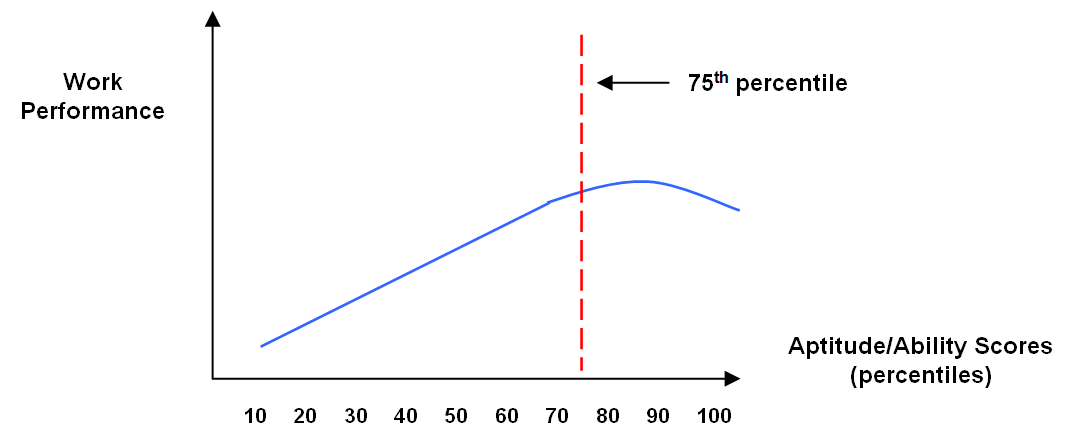How iIntelligence Helps Predict Work Performance
Intelligence or ability tests assess the ability of a person to detect relationships and to solve problems. In terms of predicting work performance, the results of certain types of ability tests can tell us the level of complexity someone is able to deal with, as well as how quickly he or she will learn.
A meta-analysis, performed on hundreds of studies investigating the relationship between intelligence and work performance, indicated that intelligence accounted for 20 to 25% of the variance in work performance (Hunter and Hunter, 1984). Statistically, this is quite a significant relationship and shows that intelligence certainly influences how people perform in their roles.
However, looking at this information in another way, it indicates that 75 to 80% of work performance is accounted for by other things. This is an important point to remember, because many organisations, and indeed people in general, tend to place far too much importance on someone’s performance on an intelligence test. In summary, assessment of intelligence is useful for predicting future work performance, but it should not be considered on its own or used to rank people.
Adequate Intelligence is Important but Higher is Not Necessarily Better
It is a common assumption that the relationship between intelligence and work performance is linear, meaning the more intelligent you are, the better your potential to perform. And if this were the case, then we could say that we should only recruit or develop those with the highest ability scores. However, the relationship between intelligence and work performance plateaus at a certain point (see diagram below). This means that as long as a candidate has ‘enough’ intelligence, then it doesn’t mean that he or she is worse off than someone who gets a higher score.
Using a Performance Benchmark Versus Incremental Rankings
A benchmark is usually recommended when judging whether a person has adequate levels of intellectual functioning – that is, for all roles, there is a level of intelligence that is required to function comfortably.
For example, as a general rule of thumb, people who cope well in middle management roles (or higher) generally have an ability score around the 75th percentile or above (compared to the normal adult population). We can see from the curve that someone at the 90th percentile is not necessarily any better (in terms of work performance) than the person at the 80th percentile.
Norms and Standardised Scores on Abilities Tests
Results from intelligence tests should always be presented as a standardised score that compares a person’s result to the normal adult population. That means that we have looked at the scores of hundreds or thousands of adults (considered to be a representative sample of the population) and plotted them out so we can work out what percentage of the population gets a certain score. So, if on a test you got a score at the 56th percentile, that would mean you were better than 56% of the adult population on that test (or in the top 44% of the population).
If we are assessing managers, we can then compare their “standardised scores” to the benchmark that is generally expected for managers. Standardised scores are useful because it means that when you assess people, you are comparing them back to the same reference framework (comparing apples with apples). If a test has been standardised it also means that it has probably been exposed to substantially more statistical rigour than most tests – the end result being that you have a test that measures what it says it measures, and is accurate in terms of the categorisation descriptions it gives people.
Which Aptitude Tests Best Predict Work Performance
Verbal (critical) and numerical reasoning ability have been found to be the most predictive tests of intellectual ability, which in turn impacts quality of problem solving. The Verbal/ Critical Thinking Test is designed to assess a person’s ability to solve problems using written materials, and at higher levels it deliberately tests the ability to problem solve and decide when there are varying shades of grey. The Numerical Reasoning Test is designed to assess a person’s ability to problem solve by detecting patterns and designing problem solving processes using numbers.
We usually administer both of these tests, as most adults tend to be good at one or the other, but not necessarily both. When we talk about someone’s overall intellectual capacity, we focus on the higher result out of these two tests, and not an average of the scores. As a simple example to explain why, we can use handedness. If we were assessing a person to write Christmas Cards, we might assess the dexterity of both their right and left hands. We would want to make sure that the dexterity score of the neatest hand met the benchmark for writing the Christmas Cards, but we wouldn’t be bothered about how messy the less neat hand was, as this would not be the hand that was used.
Unfortunately, many candidates can be dismissed based on one ability result being lower than desired – yet, the majority of the population will be stronger in one but not the other.
Other Tests of Intellectual Ability
There are many other tests that can be used to measure narrower facets of intellectual ability. These may include inductive or abstract reasoning, spatial reasoning and even mechanical reasoning. However, the variance accounted for in work performance after verbal and numerical reasoning scores have been attained is very small. The use of additional tests beyond these two is probably not worth the cost or the candidate’s time. However, in saying this, if organisations want to maintain consistency with existing testing practices, then we are able to provide the additional tests.

